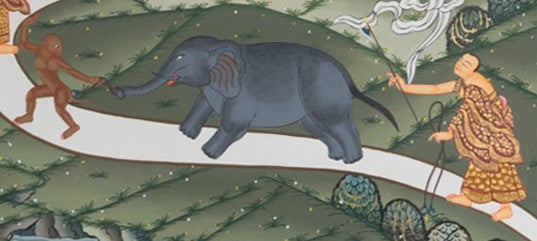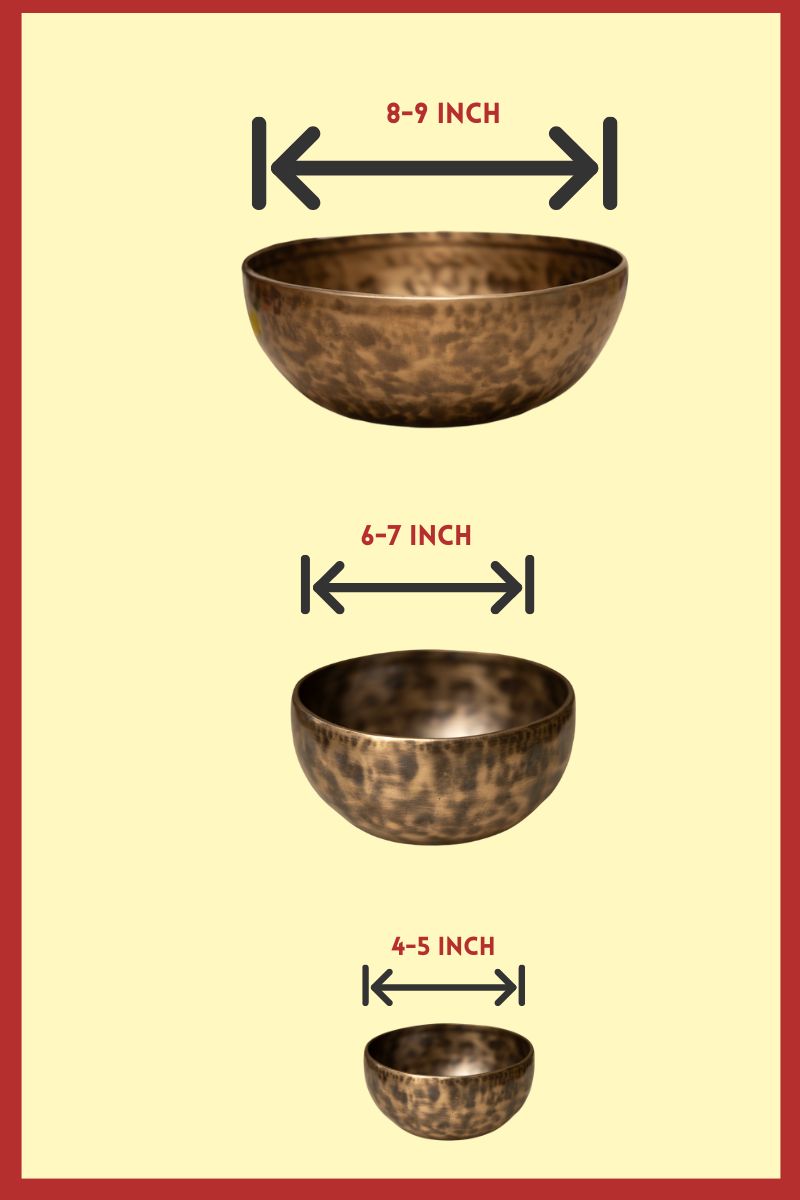Way to heaven is one of the most used Thangka painting having no any Buddhist deity or Bodhisattwa. One might wonder why the Thangka painting having a color changing elephant, monkey and a rabbit is so famous in Thangka. In this blog we will discuss all there is known about this thangka.
A way to heaven thangka is all about meditation. A human mind pure yet distracted. The feeling of attachments, aversion and delusion makes a human mind blind to the ultimate truth. It’s a Clam- abiding meditation, which helps our mind to so single-pointedly, that gradual and deepening disclosure and unpacking of these knots of obstruction occur. No spiritual path can be travelled without this deepening one-pointedness. Buddhism is concerned with true happiness not a chimera of happiness, for in Buddhist practice, Calm-Abiding results in this higher insight (vipassana) to absolute Happiness.
Those who seeks to find Vipassana, a path to the great awakening and to attain Higher Insight, Higher Consciousness and the capacity to be the of true and lasting benefits to others must practiced meditation and tame the untamed mind.

Symbols and meaning
The thangka has a monk, elephant, monkey, rabbit and a rope. And one more thing we can view is the gradually shift of colors into a white. Each of these animals portraited, rope used by monks and corners of ways used has different meaning.
The elephant is the Thangka represents our mind. If an elephant is wild, it is very dangerous to all other animals. Likewise, if the mind is not tamed it harms others. All suffering is caused by the untamed mind.
An elephant once tamed obeys its master better than any other animal; even if the master were to say pick up a very large hot ball with its trunk, the elephant will do so. Therefore, the mind when tamed, can perform any action, no matter how difficult.
The footprint of the elephant is larger than any other animals. Likewise, if our mind is tamed and comes into the realm of the Dharma, it serves its master better than any other and its capacity and scope is unlimited. If our mind is very peaceful and well tamed, there will no longer be any enemies of that person anywhere. If our mind is peaceful, we make all others around us peaceful. All the results of our mind-whether good or bad-increase, for body and speech of a person are only servants of the mind.
The monk in the drawing is the meditator. The dark color of the elephant signifies the presence of weakness and fogginess, because these two are "the darkness of the mind." The monkey's dark color symbolizes scattering of attention; its presence symbolizes distraction and scattering of focus from both inner turbulence and outer attraction. Thus, the monkey leads the elephant everywhere, always to different objects.
The rope held by the monk symbolises recollected ness; and the hook symbolizes watchfulness or alertness not only to the instruction about the practice of meditation but also to the enlarging of the undistracted field of Awareness: what is occurring and what one is doing. The fire is the energy and zest for meditation. The progressively diminishing flame, along the path, is lessening of effort needed to cultivate understanding and recollected concentration.
Cloth (touch), fruit (taste), perfume conch (smell), cymbals (hearing), and a mirror (seeing) are the distractions of the five senses and their objects because in the early stages of cultivating meditation, the attention is readily distracted by objects of the senses. The rabbit represents a more subtle aspect of scattering and fogginess, which dilutes the zest for practice and diminishes the mind's clarity.
The Nine elephants show progression on the Path to Vipassana.
How A Way to Heaven has Portrayed the meditation to reach the Vipassana?
This thangka has portraited nine stage that a human need to attain before he reaches the samsara. Each stage comes with dedication and concentration as there are many obstacles and hindrance that’s block one to reach the ultimate happiness.
1st stage: Cittasthapana / Stage of stabilizing the mind / Placement of mind.

To begin anything there requires a certain amount of spark or curiosity to know more. So, the first stage of Cittasthapana begins with study and listening to the Dharma and understanding the nature of cyclic existence. It is essential that the seeker come to realize the importance of the First Noble Truth taught by the Buddha- the “Truth of Suffering” and the reality of this Truth as a fact of life, has first to be intellectually comprehended and then further appreciated as a result of successful contemplation.
When one grows his understanding of the origin of suffering, why it exists and not only the mental pain it creates but the other two types of suffering, the suffering of change and the suffering of conditioned reflex action which creates more of the same and all ways in which suffering impacts human life. One wants to end this vicious cycle of suffering, and seek the truth, begins to focus and engage mind in meditation. To begin meditation, we start by concentrating on the rise and fall of the breath at the abdomen.
In the Thangka painting, monk – the meditator chase the elephant (the wildly untamed mind) who is following the monkey(distractions). During this stage, our mind us completely under the control of five sense objects and mental- emotional events. The rope and hook carried by monk to tame the elephant is hardly any help. At this stage, the fire of effort must be very strong.
2nd stage: Samsthapana / Continuous attention

On the beginning of second stage monk focus his mind on breath to have more concentration on his meditation. The rope and hook are needed to bind and tie elephants it means one must use remembrance and watchfulness to bring the object of meditation close. The hook makes it possible to drive the elephant in right direction.
The white spot on the head of elephant and monkey indicates that now the mind is a bit calmer. However, the five senses still distract: touch (cloth), taste (fruit), smell (perfumed conch), sound (cymbals), and sight (mirror). This second stage is gained through the power of and motivation from pondering the Dharma.
3rd Stage: Avasthapana / Repeated attention

On this third stage, smrti, the power of recollection plays an important role in meditation. The rope represents the power of recollection, which is now tied on the elephant’s neck and we can see clearly that the elephant is now gazing towards the monk, the meditator. The rabbit makes appearance and it represents the mind of passivity.
On this stage, the meditator seems to enjoy the state of "spacing out." She or he thinks that they have attained an ideal calm and everything feels good. But in reality, this is really a distraction, a subtle daze. The experienced and knowledged mediator knows there are two levels of "passivity": a basic form of 'spacing-out,' which seems very pleasant but is obviously a distraction, and a far subtler form, which seems a very peaceful state of mind, but which is really a disguised form of depression. This must be watched for by careful introspection.
Since this stage feels life reaching ideal calm, it can be mistaken for progress, it relaxes the mediator and gives him/her a pleasure. Yet this is a disturbance, this will make our mind weak and supress our desire to be energized. Like a punctured balloon, this subtle weakness will make mind weaker and weaker.
4th Stage: Upasthapana / Close attention

Alertness id the meditator and power of watchfulness plays an important role in this fourth stage of Upasthapana. We can see the dark and white colors on elephant, rabbit and monkey is exactly half-half and all of them are looking back toward the monk and rope is loose on the elephant’s neck.
This means the meditator now has recognized the mental distractions and mind now turn back to the object of contemplation. The mind is now quite obedient.
5th Stage: Damana / Tamed attention

The power of watchfulness has taken over the distraction and fogginess, now the monkey is behind the elephant. It means the mind is not under the influence of scattering distractions. Although the subtle distraction is still strong, the rabbit is yet on top of elephant. To stay focused and with clear vision to reach samsara the power of diligence and perseverance must be applied.
The rope as shown on thangka now is not so necessary but since subtle distractions is still strong, its presence is required.
6th Stage: Shamana / Pacified attention

When the sixth stage of meditation is reached, the inner emotional and mental distraction will be long gone. This is the reason why the rabbit has now disappeared form top of the elephant. The magnetism of the five senses is also gone. The energetic concentration arises, the hook and rope are no longer to be tied to the elephant, and the monk is not even looking at the elephant now.
It means now the mind has stopped from wondering as the understanding of a meditator is crystal clear. The mind now can focus on calm abiding mediation with little fire or np fire of concentration.
7th Stage: Vyupasthamana / Fully pacified attention

Upon reaching the 7th stage, the mind of the meditator reaches complete pacification. Now the Monk is behind the elephant meaning the mind to rest naturally, the concentration comes naturally and immediately but still monk observes, there still remains the subtle weakness and distraction as we can see some dark colour on the elephant. This little distraction can be eliminated with slight effort.
On this stage the monkey squats behind the monk in complete obeisance meaning mind is near reaching the samsara.
8th Stage: Ekotikarana / Single-pointed attention

Natural concentration is now present until and unless meditator wishes to stop it, the meditator has clear idea upon the object concentrated.
In the thangka this is portraited as the monk now doesn’t even have to look at the elephant, the elephant (mind) just comes and obeys. The Elephant is now completely white.
9th Stage: Upacara Samadhi / Attentional Balance

Upon reaching this stage, the meditator is not dependent upon the senses, his mind and the object become one.
The ninth stage of samadhi or mental absorption is attained through the power of total habituation, a familiarization and integration in Calm-Abiding.
Beyond the 9th Stage

After the 9th Stage of Calm-Abiding is attained, many new and extraordinary experiences come, which have never been experienced before. From the heart of the meditating monk emanates a rainbow. The monk is shown flying alone; this is bodily bliss.
Riding the elephant is the attainment of Calm-Abiding, across the rainbow is mental bliss.
Wielding the flaming sword means perfect insight, the monk returns victoriously along the rainbow; for samara's root is destroyed in union of samatha and vipasyana (sword), now with emptiness (sunyata) as the object of contemplation. The knowledge of the ultimate reality of all phenomena is known to the meditator.
From the monk's heart emanate two dark rainbows, which the monk is just about to cut asunder with his flaming sword of wisdom. These two rainbows represent karmic hindrances and mental illusion (klesa-varana), and the obscurations of the instincts of mental distortion (Uneyavarana).
The one who gain perfection in calm abiding is concentrated not only when in meditation, but in all actions.
The body feels as light as a feather. Upon achieving this goal, the meditator gains all supernatural powers like reading minds, invisibility, and transferring his consciousness into other beings. Once the meditator tames the mind, he must use it for achieving the Illumination- He/ She must become Buddha. The miracle powers are not important things. The important thing is developing the mind! One has to free one's mind from the "trap of delusion."








1 comment
Anonymous
Thank you for this explanation. I learned so much through your explanation and it made me appreciate how art can inform.